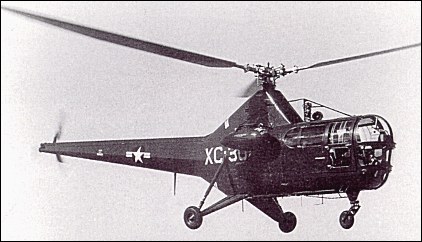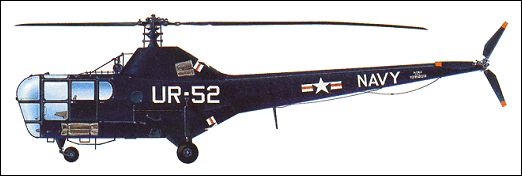
| Sikorsky S-51 / H-5 / HO3S 1910 |  |
 |

| Sikorsky S-51 / H-5 / HO3S 1910 |  |
 |
|
The first helicopter to be built in large numbers was a derivative of the Sikorsky R-5, which started out as a tandem two-seater. The first of five prototypes flew on 18 August 1943 powered by a 450hp Wasp Junior radial. This was followed by 25 YR-5A pre-production models, two of which were assigned to the Navy under the designation HO2S-1. While production of the R-5A was getting under way (34 built), five pre-series aircraft were converted into the R-5E, which had dual control, while at least 20 modified R-5As were later given new, 600hp Wasp Junior engines and redesignated R-5D. From the latter, the S-51 was developed, with a slightly enlarged four-seat cabin and a tricycle landing gear. The first commercial helicopter designed by Sikorsky, it first flew on 16 February 1946 and was certified a month later by the Civil Aviation Agency and delivered to the first customer in August. It was sold to United Air Lines and Los Angeles Airways. A total of 300 S-51s were built, some with 450hp engines, others with 600hp engines and larger diameter three-blade rotors. The military versions were designated R-5F (11 to the USAF), H-5G (38 fitted with a rescue hoist), H-5H (17 with amphibious wheel/pontoon landing gear), HO3S-1 and S2 (90 in all, naval rescue version). The S-51 had a three-blade articulated rotor, the blades of which could be folded back to facilitate stowage. The first aircraft had manual pitch control; this was later replaced by a hydraulic system. The cabin diameter was also increased. In 1947, Westland acquired the license to build the S-51 in Britain and produced 139 up to 1953. The British version, named the Dragonfly, had a 550hp Alvis Leonides engine. G.Apostolo "The Illustrated Encyclopedia of Helicopters", 1984  The S-51 has the distinction of being the first helicopter in the world to fly a regular service, and it did so in the United Kingdom. It flew in British European Airways' colours between Liverpool and Cardiff in June 1950. Work on the S-51 began in 1943 when the United States Army Air Force put out a requirement for a helicopter bigger and better than the rather crude Sikorsky R-4. The civil version flew for the first time in February 1946. It could carry four passengers and retained the R-985-AN-5 radial engine of the military version. The Civil Aviation Administration certification was granted a month later and in August 1946 the first customer took delivery. Production lasted until 1951, by which time Sikorsky had built 285 machines. In December 1946 Westland Aircraft of Yeovil purchased a licence to build the S-51 in Britain. When they ceased production in 1953 they had built 139 machines. The Dragonfly, as the British-built machine was known, had a 520hp Alvis Leonides engine. Westland sold their UK-built helicopters to Belgium, Ceylon, Egypt, France, Iraq, Italy, Japan, Thailand and Yugoslavia. The bulk of these sales were for military use, but Belgium became a European pioneer in the civil field when Sabena bought three. The S-51 had a three-blade rotor which had flapping and drag hinges and could be folded to facilitate storage. The early machines had manual control for the rotor pitch, later replaced by hydraulic servo-controls with power from a hydraulic pump driven by the tail transmission shaft. In 1955 Westland produced a conversion of the S-51 which they called the Widgeon. It had a four-blade main rotor with a 520hp Leonides 521 engine, a redesigned cabin and small clamshell nose doors. The first flight was in August 1955 with a Dragonfly converted to Widgeon standard. Westland produced 15 Widgeons and sold them to Ceylon, Jordan, Brazil and the Hong Kong police department. The Widgeon used an S-55 rotorhead which employs an offset flapping-hinge system, thus allowing more latitude in the centre of gravity and the position of cargo or passengers. The Widgeon was the final development of the S-51 which was becoming obsolete with the rapid changes in helicopter design in the mid 1950s. Bill Gunston "The Illustrated Encyclopedia of Commercial Aircraft", 1980
- Westland built the R-5 under licence in Britain as the WS.51 Dragonfly, for the RAF, Royal Navy and civil operators. - Nine HO3S-1s were used by the US Coast Guard as HO3S-1Gs. - HO3S-1s served with distinction in the Korean War with Squadron HU-1. - In 1950 Sikorsky built and tested a single XHO3S-3 with a redesigned rotor head and blades. - Two XR-5As were fitted with British instruments to an RAF requirement. - The R-5B, R-5C and HO3S-2 were planned variants later cancelled.
|